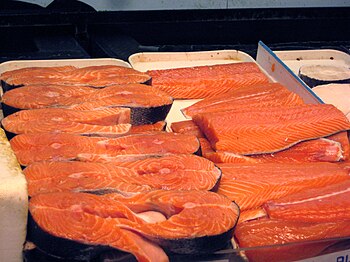 |
| Salmon intended for consumption as food (Photo credit: Wikipedia) |
Ingredients:-
6 oz. of salt to each gallon of water, sufficient water to cover the fish.
Mode:-
Scale and clean the fish, and be particular that no blood is left inside; lay it in the fish-kettle with sufficient cold water to cover it, adding salt in the above proportion. Bring it quickly to a boil, take off all the scum, and let it simmer gently till the fish is done, which will be when the meat separates easily from the bone. Experience alone can teach the cook to fix the time for boiling fish; but it is especially to be remembered, that it should never be underdressed, as then nothing is more unwholesome. Neither let it remain in the kettle after it is sufficiently cooked, as that would render it insipid, watery, and colourless. Drain it, and if not wanted for a few minutes, keep it warm by means of warm cloths laid over it. Serve on a hot napkin, garnish with cut lemon and parsley, and send lobster or shrimp sauce, and plain melted butter to table with it. A dish of dressed cucumber usually accompanies this fish.
Time. 8 minutes to each lb. for large thick salmon; 6 minutes for thin fish.
Note. Cut lemon should be put on the table with this fish, and a little of the juice squeezed over it is considered by many persons a most agreeable addition. Boiled peas are also, by some connoisseurs, considered especially adapted to be served with salmon.
Salmon and caper sauce.
Ingredients:-
2 slices of salmon, 1/4 lb. butter, 1/2 teaspoonful of chopped parsley, 1 shallot; salt, pepper, and grated nutmeg to taste.
Mode:-
Lay the salmon in a baking dish, place pieces of butter over it, and add the other ingredients, rubbing a little of the seasoning into the fish; baste it frequently; when done, take it out and drain for a minute or two; lay it in a dish, pour caper sauce over it, and serve. Salmon dressed in this way, with tomato sauce, is very delicious.
Time. About 3/4 hour.
Collared salmon.
Ingredients:-
A piece of salmon, say 3 lbs., a high seasoning of salt, pounded mace, and pepper; water and vinegar, 3 bay leaves.
Mode:-
Split the fish; scale, bone, and wash it thoroughly clean; wipe it, and rub in the seasoning inside and out; roll it up, and bind firmly; lay it in a kettle, cover it with vinegar and water (1/3 vinegar, in proportion to the water); add the bay leaves and a good seasoning of salt and whole pepper, and simmer till done. Do not remove the lid. Serve with melted butter or anchovy sauce. For preserving the collared fish, boil up the liquor in which it was cooked, and add a little more vinegar. Pour over when cold.
Time. 3/4 hour, or rather more.
Curried salmon.
Ingredients:-
Any remains of boiled salmon, 3/4 pint of strong or medium stock, 1 onion, 1 tablespoonful of curry powder, 1 teaspoonful of Harvey's sauce, 1 teaspoonful of anchovy sauce, 1 oz. of butter, the juice of 1/2 lemon, cayenne and salt to taste.
Mode:-
Cut up the onions into small pieces, and fry them of a pale brown in the butter; add all the ingredients but the salmon, and simmer gently till the onion is tender, occasionally stirring the contents; cut the salmon into small square pieces, carefully take away all skin and bone, lay it in the stewpan, and let it gradually heat through; but do not allow it to boil long.
Time. 3/4 hour.
Salmon cutlets.
Cut the slices 1 inch thick, and season them with pepper and salt; butter a sheet of white paper, lay each slice on a separate piece, with their ends twisted; broil gently over a clear fire, and serve with anchovy or caper sauce. When the higher seasoning is required, add a few chopped herbs and a little spice.
Time. 5 to 10 minutes.
Salmon a la genevese.
Ingredients:-
2 slices of salmon, 2 chopped shallots, a little parsley, a small bunch of herbs, 2 bay-leaves, 2 carrots, pounded mace, pepper and salt to taste, 4 tablespoonfuls of Madeira, 1/2 pint of white stock, thickening of butter and flour, 1 teaspoonful of essence of anchovies, the juice of 1 lemon, cayenne and salt to taste.
Mode:-
Rub the bottom of a stewpan over with butter, and put in the shallots, herbs, bay leaves, carrots, mace, and seasoning; stir them for 10 minutes over a clear fire, and add the Madeira or sherry; simmer gently for 1/2 hour, and strain through a sieve over the fish, which stew in this gravy. As soon as the fish is sufficiently cooked, take away all the liquor, except a little to keep the salmon moist, and put it into another stewpan; add the stock, thicken with butter and flour, and put in the anchovies, lemon juice, cayenne, and salt; lay the salmon on a hot dish, pour over it part of the sauce, and serve the remainder in a tureen.
Time. 1-1/4 hour.






